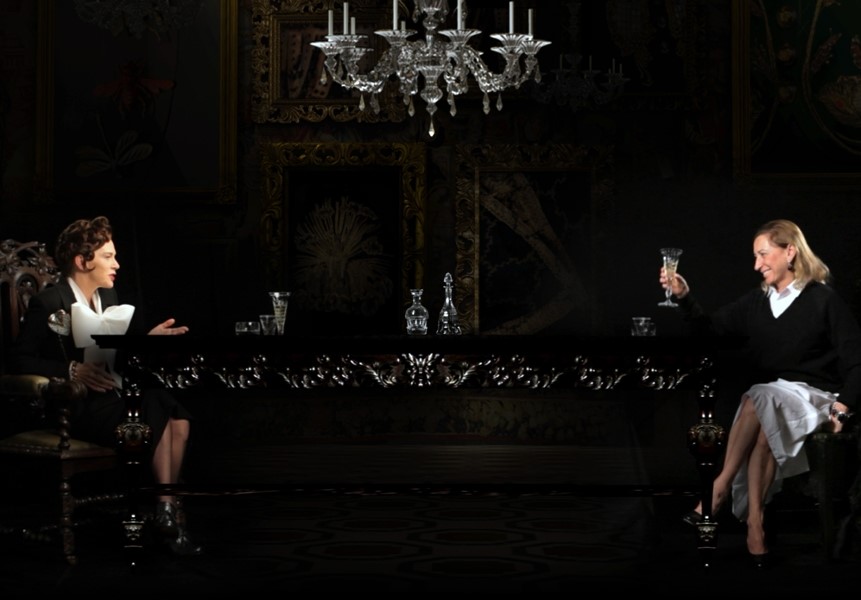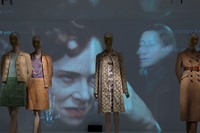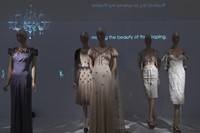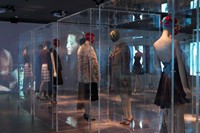AnOther speaks with legendary film director Baz Luhrmann about the current Schiaparelli and Prada: Impossible Conversations at the Met...
“All my life is working against the cliché of beauty”, announces Miuccia Prada across the table to Elsa Schiaparelli. But this is no ordinary dialogue but rather an “imaginary conversation” between one living designer and one long dead (and played by the great Australian actress, Judy Davis) dreamt up by curator, Andrew Bolton and the iconoclastic film director, Baz Luhrmann. Filmed as a series of short films that play during the current exhibit at the Metropolitan Museum, Schiaparelli and Prada: Impossible Conversations; these surrealist vignettes serve to highlight some of the similarities and shared vision between these two women, separated by time and space. And as Luhrmann has lavishly proven in frenetic, hyper-saturated spectacles like Moulin Rouge! and Romeo and Juliet, historical inaccuracy has never been a deterrent to a great story. He took a break from postproduction on the breathlessly awaited remake of The Great Gatsby to speak to AnOther.
You directed the performance by Florence and the Machine at last year’s Met Ball – how did the opportunity to creative direct the entire production this year come about?
On a few occasions, over several years, Anna Wintour asked Catherine [Martin, Baz;s wife] and I to do the exhibition. We always wanted to do it as a gesture of friendship and support for the Met, because Catherine and I have utilised the Costume Institute archives on all of our shows for costume research, and really it is a fantastic resource. But finding the time was difficult. Last year, I volunteered to stage the Florence and the Machine performance as a tribute to Alexander McQueen, and enjoyed it. This year, we wanted to do more, but have had our heads down, so focused on ‘Gatsby’, that I wasn’t sure we could be of help. But then I found out Miuccia was involved. She is a really dear friend and great collaborator (she helped design Leo’s suit for Romeo and Juliet; and she and her husband, Patrizio were the first to see and support the film), and so it was difficult to decline. Working with Miuccia is always amazing intellectually and artistically. So when she and Anna asked me to be an adviser this year, I said yes. I think that perhaps because of my friendship with Miuccia, I was then in a position to help her speak freely, and so it was I who played Schiaparelli across the table when we first shot Miuccia. Surely, a surreal experience. Then I was replaced, and we shot with the one-of-a kind Judy Davis, who was acting to the already filmed footage of Miuccia. Believe it or not, despite the illusion of them together across the table in the clips, those two had never actually met until the night of the ball. Despite the challenges, given my commitment to Gatsby, and quite often being on the other side of the world, in Australia, I did find it very enriching to be creatively involved with Miuccia, Anna, Judy, the Costume Institute, Andrew Bolton, and Harold Koda.
You’ve known Miuccia Prada for many years –what do you find inspiring about her?
Her ability, despite the temptation to follow obvious commercial trends, to face her inner self and allow her life to be expressed through her art, while at the same time having her feet, as she says, “attached to reality.” This need for balance between reality and the inescapable desire toward self-expression is one I really relate to. On top of it all, and here she really does inspire me, she manages to give priority to family. This is the high-water-mark of how to live your life.
What was the thinking behind casting Judy Davis as Schiap?
My very first professional engagement as a young actor was with Judy Davis. I was in high school and Judy somewhat took me under her wing, and I even lived at her house for a bit. She had then just finished making a film with the great David Lean, A Passage to India, for which she was nominated for an Oscar, and so you can imagine how, as an 18-year-old, I felt. I have always wanted to work with Judy again. But many factors have conspired against it. With Schiaparelli, I knew that because Judy would be acting to a video already created of Miuccia, I needed a truly remarkable actor. It was a big ask and I can only be very thankful that she said yes, as everything for the Met is voluntary; no fee involved.
"Their greatest similarity is the direct and indivisible line between their life and their creativity"
What similarities did you find between the two designers in the course of researching this project?
“Similar but different,” as Miuccia says to Schiaparelli and Schiaparelli to Miuccia in the films. Their greatest similarity is the direct and indivisible line between their life and their creativity. And it is also interesting that both women came from a Catholic-Italian background, and somehow went from a conservative upbringing to the most individual and free expression, not only in their fashion, but also in their lives. They are extreme individuals.
In one of the conversations, Miuccia and Schiap disagree about whether fashion is art- what’s your own personal take on this?
I am very clear about this. And Miuccia and I laugh about it. In the videos that you see in the exhibit at the Met, Miuccia is really talking across the table to me (Judy Davis was filmed later). So, in fact, it is Miuccia and I having a debate about fashion versus art. Simply, to me, fashion, particularly at the level of Miuccia and Schiaparelli, is art. Of course there are people who do fashion simply to follow a profitable commercial current, just as there are people who do modern art, copying what someone else has already plucked from their own imagination and realized through their sweat. But when it comes to true, directional fashion, the stuff that makes an imprint, or captures somehow the zeitgeist of a time, the stuff that is realized through pure imagination, accompanied by deep individual expression, and accomplished through sweat and fear, plus a whole big wad of hard work… Well this is art.
You’ve directed Nicole Kidman in a film for Chanel and now this Met exhibit – what do you enjoy about collaborating in the world of fashion?
The world of fashion is almost inseparable, from my point of view, from the world of cinema, theatre, opera, art, and I guess the next logical step, from life itself. Storytelling is defined by human nature. Human nature is defined by character. Character is defined by action. And the first action most people take in the morning is to put on clothes. And so it follows that fashion, by its very nature, whether it be the working clothes put on by a potato farmer, or the couture designs put on by someone in the front row of a runway show, or someone dressing for battle, those elements of self expression and pragmatics are a direct flag to the inner DNA the inner personality and character of every human being.
Can you tell us anything about Miuccia’s contribution to the costumes of ‘The Great Gatsby’?
Yes. Miuccia and Catherine and I go way back, 16 years. As I mentioned, we did our first collaboration on Romeo and Juliet, on Leo’s suit. Since then we have been great friends. We had always hoped to work together again. And so Catherine and I reached out to her, whose real motivation is simply, that she though the idea of the film and its relevance to this moment was credible and thrilling, and so she wanted to involved to support the project. Of course, as with all she does, the result was a complete and fulfilling collaboration.
Schiaparelli and Prada: Impossible Conversations runs until August 19.
Text by Kin Woo



